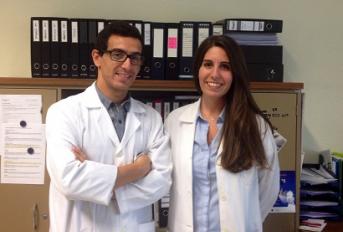Associação Portuguesa de Investigação em Cancro
miR125b and miR-34a as potential biomarkers of HPV infection and development of cervical cancer
miR125b and miR-34a as potential biomarkers of HPV infection and development of cervical cancer

Authors and Affiliations:
Joana Ribeiro,1,2,3 Joana Marinho Dias,1,2,4 Paula Monteiro,5 Joana Loureiro,5 Inês Baldaque,1 Rui Medeiros,1,2,4,6 and Hugo Sousa 1,2
1 Virology Service, Portuguese Institute of Oncology of Porto, Portugal
2 Molecular Oncology and Viral Pathology Group (CI-IPOP), Portuguese Institute of Oncology of Porto
3 Faculty of Medicine, University of Porto (FMUP), Portugal
4 Abel Salazar Institute for the Biomedical Sciences (ICBAS), University of Porto, Portugal
5 Department of Pathology of Portuguese Institute of Oncology of Porto, Portugal
6 Research Department, Portuguese League against Cancer (LPCC-Núcleo Regional do Norte), Porto, Portugal
Abstract:
We aimed to characterize miR-125b and miR-34a expression in 114 women with different cervical lesions: normal epithelium with (n = 20) and without (n = 29) HPV infection; LSIL (n = 28); HSIL (n = 29); and ICC (n = 8). miRNA expression analysis was performed by comparing the distinct groups with the reference group (women with normal epithelium without HPV). For miR-125b, we observed a twofold (2−ΔΔCt = 2.11; P = 0.038) increased expression among women with normal epithelium with HPV infection and a trend of downregulation in different cervical lesions including an 80% reduction (2−ΔΔCt = 0.21; P = 0.004) in ICC. Similarly, miR-34a expression analysis revealed an increased expression (2−ΔΔCt = 1.69; P = 0.049) among women with normal cervix and HPV infection, and despite no significant correlation with cervical lesions, its expression was increased by twofold (2−ΔΔCt = 2.08; P = 0.042) in ICC. Moreover, miR-125b levels were able to predict invasive cancers with 88% sensitivity and 69% specificity. Results showed that while miR- 34a expression seems to be correlated with invasive cervical cancer, miR-125b expression is significantly changed within the different cervical lesions and their levels should be further investigated as possible predictive/prognostic biomarkers using a noninvasive approach.
Journal: BioMed Research International




